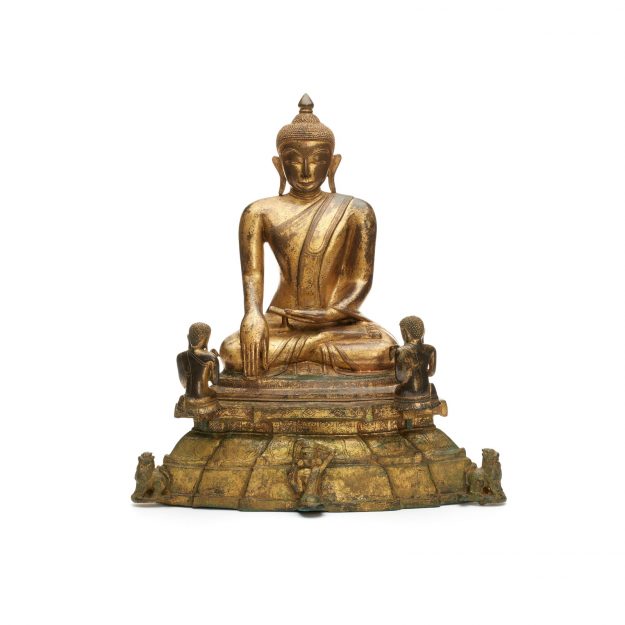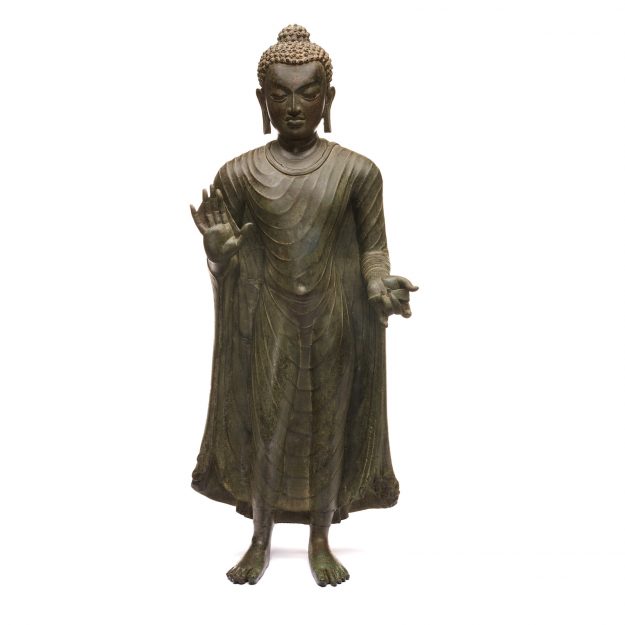Grand and utterly pristine, the opening sculpture in Asia Society’s current exhibit, “Buddha, Sage of the Shakya Clan: Masterworks from the Mr. and Mrs. John D. Rockefeller 3rd Collection,” sets the tone for a stunning collection of Buddha images illuminated by a manuscript that depicts the “eight great events” in the Buddha’s life. The 2nd-century head of Shakyamuni Buddha, the oldest artwork in the exhibit, comes from Gandhara, an area that covers present-day northern Pakistan and eastern Afghanistan, during a period when the first human images of the Buddha were appearing. With its strong Hellenistic influence, a hallmark of Gandharan art, the Buddha head also displays many of the lakshana, or marks of perfection, belonging to the Buddha, including a perfectly symmetrical face, snail-shell curls, and the ushnisha, or cranial protuberance, atop his head. Unique for works of art this old, the head is perfectly intact—not even the earlobes or tip of the nose have been repaired.
Impressively, the rest of the fifteen objects in the exhibit—thirteen of which come from the Mr. and Mrs. John D. Rockefeller collection—are similarly pristine. Curated by Laura Weinstein, the John H. Foster Associate Curator of Pre-Modern Art at Asia Society, and on view through August 27, the thoughtfully paced show allows viewers to spend ample time with and between each piece of art. As magnificent as each one is, not one of them overwhelms or distracts from the other. Together, they reveal how representations of the Buddha, as well as the way Buddhists practice, change over time and across cultures.
An 11th-century sculpture is significant not just because a Tamil inscription at the base reveals that it was created by a metalworkers’ guild at the Buddhist site of Nagapattinam, an important place of worship in present-day Tamil Nadu. Two holes in the base also point to the rich but underappreciated processional tradition in South Indian Buddhism, wherein worshippers would carry the Buddha image around for everyone to see. The ushnisha on this sculpture is in the form of a flame, characteristic of Buddhas found throughout Southeast Asia, which were influenced by this work, or others very similar to it.

A beautiful 14th-15th-century gilded bronze sculpture from Myanmar that depicts the Buddha flanked by two disciples represents Burmese style. Here, the ushnisha takes the shape of a jewel, another common representation in Southeast Asia. Interestingly, the two attendants face the Buddha rather than the viewer, in a highly unusual orientation. The base of the statue is an anthropomorphized representation of the earth in female form, wringing water from her hair at the moment of the Buddha’s enlightenment.
Another small, elegant bronze figure—this one from the 9th century—is typical of Thailand. Given its green patina, the sculpture was likely found buried underground. It has a unique combination of posture and mudra, where his hands are in the dharmachakra mudra—the teaching gesture—but are separate, and the Buddha is standing, not sitting.
Around the corner, a spectacular, repair-free, Gupta-era sculpture from the late 6th century in Sarnath, where the Buddha delivered his first teaching, demonstrates more lakshana, including heavy-lidded eyes, webbed fingers and toes, and upturned fingertips and toes. With pronounced drapery close to his body, the sculpture represents a more androgynous Buddha than the masculine one in earlier depictions.

On the wall nearby, an 18th-century Korean painting that was originally commissioned for a royal setting shows the Buddha, accompanied by a number of bodhisattvas and arhats, delivering the Lotus Sutra while faint rays of light emanate from his head.
Like this intricate painting and many of smaller statues, a remarkably intact palm leaf manuscript toward the opening of the show invites viewers in for a close look at the so-called eight great events in the Buddha’s life, including scenes from the birth of the Buddha at Lumbini, the Buddha’s awakening at Bodhgaya, his first teachings at Sarnath, his display of miracles at Shravasti, his descent from heaven where he taught the gods and his mother, his taming of the mad elephant, his accepting honey from a monkey, and his death, or parinirvana, at Kushinagar. The manuscript was created at Nalanda, the great monastic center and university in northeast India, most likely in the 10th century, but the text tells us that it made its way to Nepal and then Tibet, where it landed in the hands of monastics, including Buton Rinchen Drub, who compiled the first Tibetan Kangyur. (Read more about the manuscript’s history here.) The eight great events depicted here are blown up on panels on the wall, providing narrative context for the artwork.
While the provenance of each piece is carefully detailed, viewers may be left wondering where the artwork was before the Rockefellers collected them—origin being an issue all museums and art institutions are grappling with today. Similarly, objects of worship like these, some of which are encased in glass, may feel sterile to some viewers. But the setting for each piece is carefully controlled, for humanity and light, to maintain its condition. As with all art exhibits, viewers’s responses will vary.
What is unquestionable is the exceptional quality of each object in the exhibit, the evident care that went into selecting them, and the clear appreciation for them—an appreciation all viewers will experience themselves.
Thank you for subscribing to Tricycle! As a nonprofit, we depend on readers like you to keep Buddhist teachings and practices widely available.